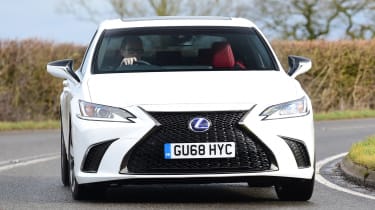Lexus ES review - Engines, performance and drive
The ES is easy to drive and undemanding, but isn’t well suited to enthusiastic driving

As with much of the Lexus range, the ES puts comfort ahead of other considerations, and it’s this aspect that dominates the driving experience. Everyone inside will enjoy the smooth ride that deals well with a variety of surfaces and remains composed on motorways or in town. This is helped by the excellent refinement of the powertrain, with the petrol engine and electric motor combining well to provide quiet, fuss-free motoring. This is particularly apparent when driving in traffic, where the car’s ability to operate on electric power only emphasises the sense of quiet within the cabin.
On more challenging roads, the ES retains its composure, and when driven at high speed the steering responds well, with good feedback and accurate responses to the driver’s inputs. The Lexus ES also features a new type of suspension damper called a Swing Valve Shock Absorber, the idea being that a valve inside the system helps it to respond better to bumps in the road and cornering loads. The result is that the ES corners relatively flat for a car of this size and is largely untroubled by road imperfections. What the Lexus ES lacks is the sharpness offered by rivals such as the BMW 5 Series and is more biased towards comfort than the Mercedes E-Class, which manages to be relaxing and enjoyable to drive, too.
Go for an F Sport model, and the standard adaptive suspension is firmer than in the lesser-equipped versions. Combine this with the 18-inch wheels, and the ES’s focus on comfort is lost somewhat.
More reviews
Car group tests
In-depth reviews
Road tests
Used car tests
The powertrain of the ES is also not best suited to enthusiastic driving. When driven in normal conditions it operates very well, with the engine and electric motor combining with the CVT automatic transmission to keep the engine dormant or at low revs as much as possible. Demand brisk acceleration, however, and the ES struggles, with the engine revving hard but delivering less performance than diesel rivals.
Engines, 0-60 acceleration and top speed
The ES is available with a single powertrain, a 2.5-litre four-cylinder petrol engine matched with an electric motor and battery pack, to give a total output of 215bhp. As mentioned there’s a single gearbox option, too, a CVT automatic transmission. The ES accelerates from 0-62mph in 8.9 seconds, as much as a second slower than comparable rivals from BMW and Mercedes, while its top speed is also a modest 112mph.
When driven at normal speeds the powertrain delivers smooth and quiet operation, with the gearbox operating with impressive efficiency. However, when strong acceleration is demanded, the four-cylinder unit shows some harshness as it sits at high revs, with only modest acceleration delivered. The CVT is an improvement on past Lexus models, though, so will be pleasing to use for existing Lexus owners.









